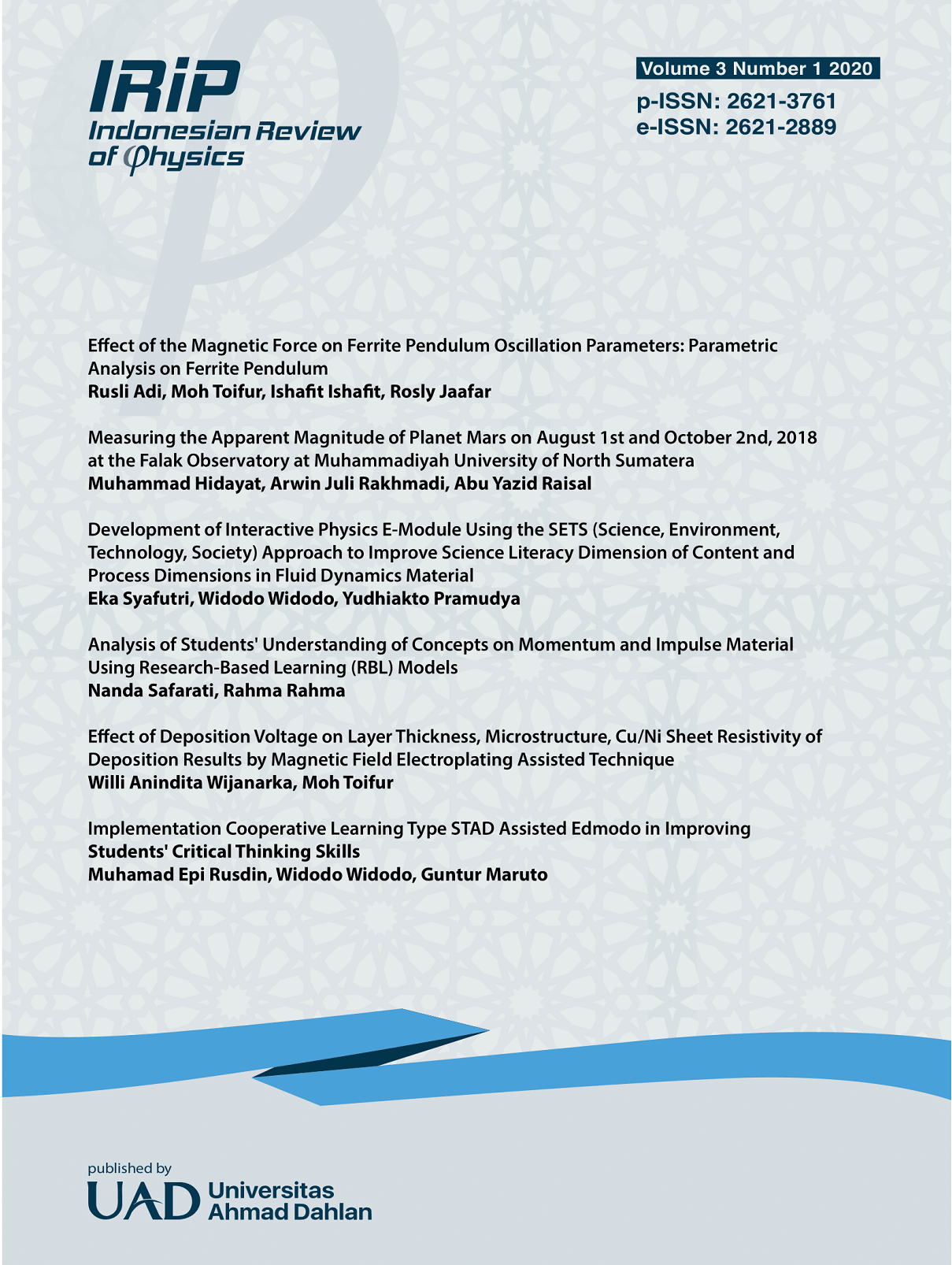Analysis of Students' Understanding of Concepts on Momentum and Impulse Material Using Research-Based Learning (RBL) Models
DOI:
https://doi.org/10.12928/irip.v3i1.1944Keywords:
Concept understanding, Momentum and impulse, Research-Based LearningAbstract
This study aims to analyze students' understanding of concepts in the material of momentum and impulses using research-based learning (RBL) models. This type of research is quantitative research with a descriptive approach. The population in this study were students of class XI of SMA 3 Bireuen, the subjects in this study were students of class XI2 of SMA 3 Bireuen as many as 30 students. The results of this study indicate that 30 students in class XI2. 53.3% of students in the category understood the concept, 20% students in the guessing category and 26.7% students in the don't understand the category. This shows students will better understand the concepts of momentum and impulses by using research-based learning models.References
[2] H. Gardner, The Disciplined Mind: What All Students Should Understand. New York: Simon & Schuster, 1999.
[3] F. Alatas, “Hubungan Pemahaman Konsep dengan Keterampilan Berpikir Kritis Melalui Model Pembelajaran Treffinger pada Mata Kuliah Fisika Dasar,†Edusains UIN Syarif Hidayatullah, vol. 6, no. 1, pp. 88–96, 2014.
[4] L. Deviyanti, “Pengembangan Panduan Praktikum Fisika Berbasis Research Based Learning Untuk Mengoptimalkan Domain Kognitif dan Psikomotorik Siswa di SMA Negeri 5 Purworejo.†Program Studi Pendidikan Fisika FKIP Universitas Muhammadiyah Purworejo, 2016.
[5] P. R. Sasmita, “Penerapan Metode Inkuiri Terbimbing Menggunakan Media Kit Fisika: Upaya Meningkatkan Aktivitas dan Hasil Belajar Fisika Siswa,†J. Ilm. Pendidik. Fis. Al-Biruni, vol. 6, no. 1, pp. 95–102, 2017.
[6] Y. T. B. Widodo, Cara Cerdas Mengerjakan Soal Fisika Mekanika Untuk SMA/MA: Brilliant Solution. Yogyakarta: Andi Offset, 2007.
[7] S. Rahmawati, S. Kusairi, and S. Sutopo, “Analisis Penguasaan Konsep Siswa yang Belajar Materi Momentum dan Impuls Berbasis Scientific Approach Disertai Formative Assessment Berbantuan Web,†J. Pembelajaran Sains, vol. 3, no. 1, pp. 1–6, 2019.
[8] BSNP, “Permendiknas RI No. 22 Tahun 2006 Tentang Standar Isi untuk Satuan Pendidikan Dasar dan Menengah.†Jakarta, 2016.
[9] A. B. Trisnasih, K. C. Suryandari, and Suhartono, “Peningkatan Keterampilan Proses dan Hasil Belajar IPA melalui Model Research Based Learning Siswa Kelas V SD,†Kalam Cendekia, vol. 4, no. 4, pp. 1–7, 2016.
[10] L. W. Anderson and D. R. Krathwohl, A Taxonomy for Learning Teaching and Assessing: A Revision of Bloom’s Taxonomy of Educational Objetives. New York: Longman, 2001.
[11] Rusman, Model-Model Pembelajaran. Jakarta: PT Raja Grafindo Persada, 2010.
[12] R. Soedjadi, “Kiat Pendidikan Matematika di Indonesia.†Direktorat Jenderal Pendidikan Tinggi, Departemen Pendidikan Nasional, Jakarta, 2000.
[13] S. Nasution, Berbagai Pendekatan dalam Proses Belajar dan Mengajar. Jakarta: Bumi Aksara, 2005.
[14] M. Gusniwati, “Pengaruh Kecerdasan Emosional dan Minat Belajar Terhadap Penguasaan Konsep Matematika Siswa dalam SMAN di Kecamatan Kebun Jeruk,†J. Form., vol. 5, no. 1, pp. 26–41, 2015.
[15] M. Salimi, T. S. Susiani, and R. Hidayah, “Research Based Leaning Sebagai Alternatif Model Pembelajaran di Lembaga Pendidikan Tenaga Kependidikan,†J. Pendidik. Sekol. Dasar, vol. 3, no. 1, pp. 1–9, 2017.
[16] S. M. Wardoyo, Pembelajaran Berbasis Riset. Jakarta: Akademia, 2013.
[17] P. Tremp, “Research-Based Teaching and Learning: A LERU Project.†University of Zurich, Munich, 2010.
[18] Sugiyono, Metode Penelitian Pendidikan Pendekatan Kuantitatif, Kualitatif dan R&D. Bandung: Alfabeta, 2013.
[19] W. P. Sari, E. Suyanto, and W. Suana, “Analisis Pemahaman Konsep Vektor pada Siswa Sekolah Menengah Atas,†J. Ilm. Pendidik. Fis. Al-Biruni, vol. 6, no. 2, pp. 159–168, 2017.
Downloads
Published
Issue
Section
License
Authors who publish in IRiP agree to the following terms: Authors retain copyright and grant the IRiP right of first publication with the work simultaneously licensed under a Creative Commons Attribution License (CC BY-SA 4.0) that allows others to share (copy and redistribute the material in any medium or format) and adapt (remix, transform, and build upon the material) the work for any purpose, even commercially with an acknowledgment of the work's authorship and initial publication in IRiP. Authors are able to enter into separate, additional contractual arrangements for the non-exclusive distribution of the journal's published version of the work (e.g., post it to an institutional repository or publish it in a book), with an acknowledgment of its initial publication in IRiP. Authors are permitted and encouraged to post their work online (e.g., in institutional repositories or on their website) prior to and during the submission process, as it can lead to productive exchanges, as well as earlier and greater citation of published work (See The Effect of Open Access).















